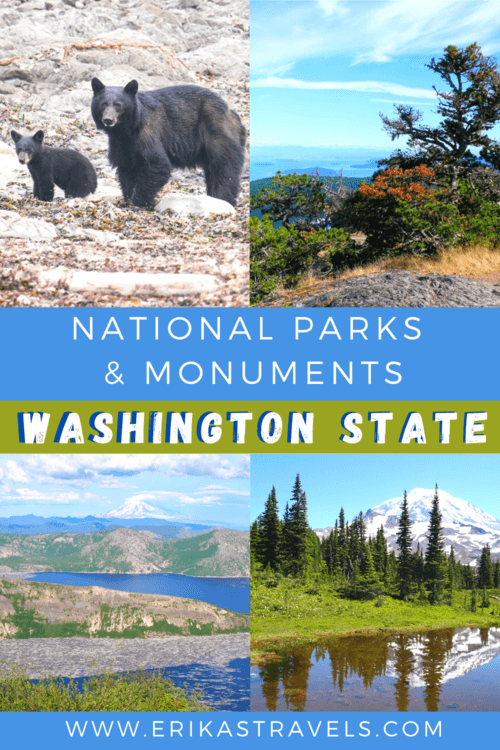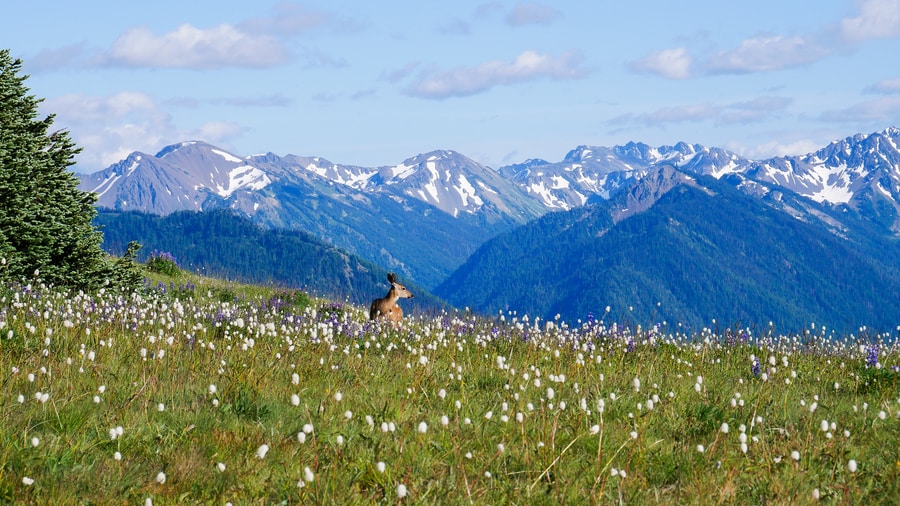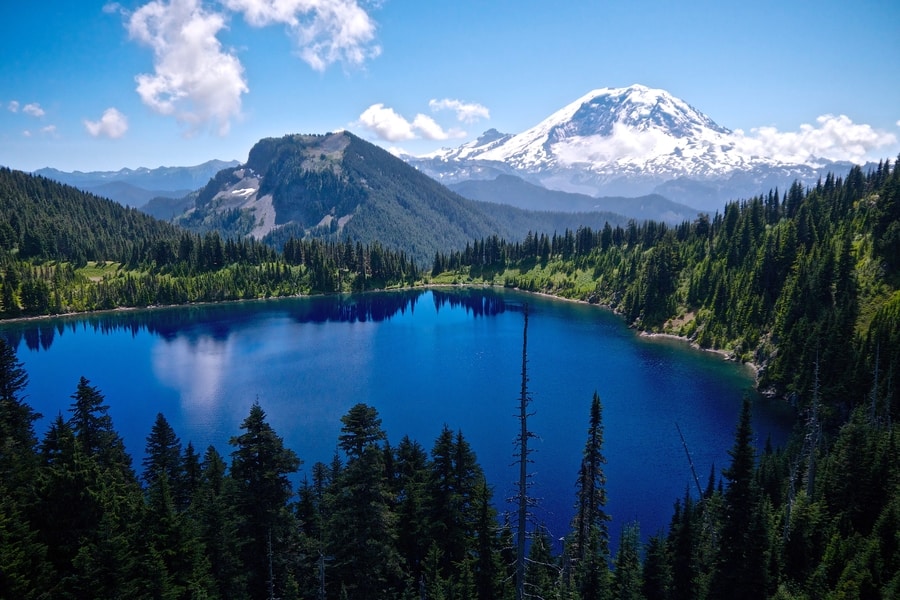
National Parks and Monuments in Washington State
Washington’s national parks and monuments boast jewel-like islands, misty forests, soaring mountains, arid scablands, and flat featureless desert. They cover roughly a quarter of the state’s total area and encompass many of its different ecosystems.
Yet despite its geographical diversity, Washington State remains best known for its emerald-carpeted forests, its mountain-clad topography, and its heavy rainfall.
And, to some extent, it isn’t difficult to see why.
After all, the western portion of Washington houses more than three quarters of the state’s population and attracts a large majority of its tourists.
But Washington is so much more than its densely-populated western half. Visiting Washington State’s national parks, monuments, forests, and recreation areas, reveals a state that is as arid as it is luscious, as expansive as it is vertical, and as barren as it is green.
WASHINGTON’S STATE NATIONAL PARK SYSTEM
The federal government owns more than a quarter of Washington’s land. The protected areas—mostly focused around the Olympic Peninsula and Cascade Mountain Range—are magnets for hikers, mountain climbers, animal lovers and nature enthusiasts.
Washington’s National Park Service (NPS) sites include three national parks, three national monuments, five national forests, and three national recreation areas. In addition, the NPS oversees a handful of historic sites and wildlife refuges.
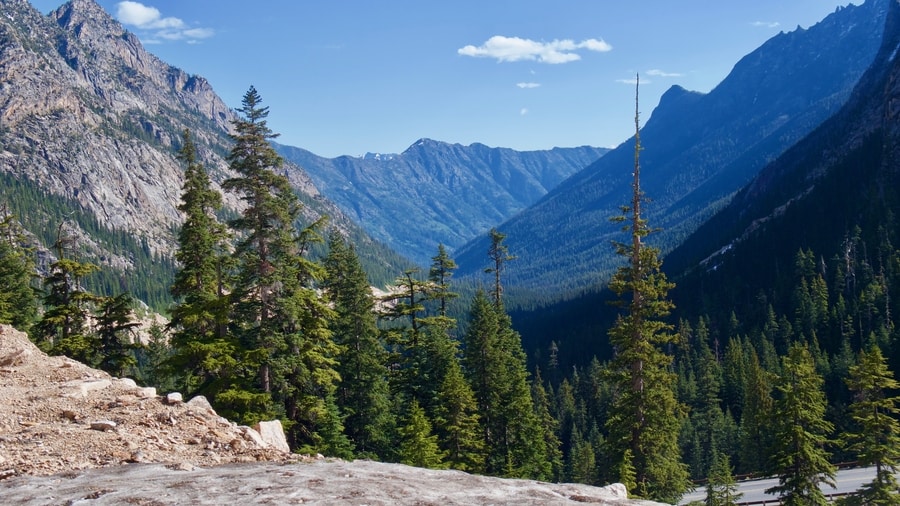
In the six years that I have lived in Washington, I’ve visited most of the state’s protected parks, monuments and forests. The areas I have yet to visit include the Hanford Reach National Monument, the Colville National Forest, and the Roosevelt Lakes National Recreation Area.
NATIONAL PARKS IN WASHINGTON STATE
Washington State’s three national parks highlight the drama of the Pacific Northwest’s mountain-clad landscape. They each lie in the western half of the state and feature snow-capped peaks, coniferous forests, and alpine lakes.
I’ve had the fortune of visiting each of Washington’s national parks during my time spent living in Seattle. Each offers a plethora of activities, hiking trails, photo opportunities, and scenic drives.
-
MOUNT RAINIER NATIONAL PARK
Mount Rainier National Park is Washington State’s most renowned natural landmark. The mountain is the contiguous USA’s fifth-tallest peak and an enduring symbol of the Cascade Range.
The national park lies between Seattle and Portland, just east of the 15 Corridor. It makes for a spectacular (albeit crowded) weekend trip during summer months.
Within its confines, Mount Rainier National Park hosts an ecosystem that is studded with geologic wonders. It boasts gushing waterfalls, wildflower-strewn meadows, and mile upon mile of forested trails.
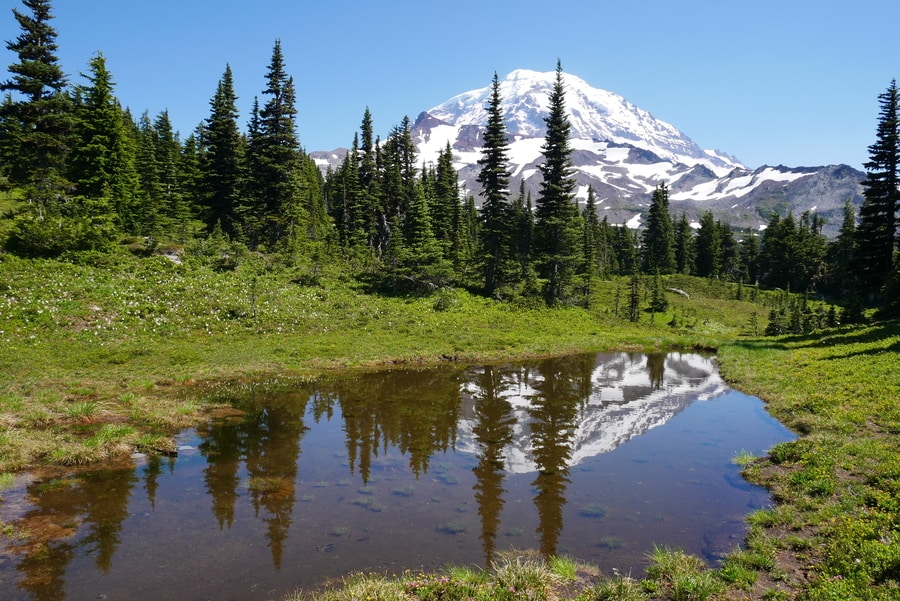
Top places to visit in Mount Rainier include Spray Park, the Skyline Trail at Paradise, the Grove of the Patriarchs, and the Sunrise Visitor Center.
-
OLYMPIC NATIONAL PARK
Olympic National Park is one of the Pacific Northwest’s most wild and scenic areas. Encompassing large swaths of an eponymous peninsula, the UNESCO-recognized gem showcases temperate rainforests, glaciated mountain peaks, and dramatic wind-battered beaches.
Olympic National Park’s three main sections are largely independent from one another. On its western flank, the park is home to rocky monolith-strewn beaches akin to those of the Oregon Coast. Inland, it features dense temperate rainforests carpeted in thick mosses and luscious vegetation. At its center, 8,000+ foot snowcapped mountains soar overhead.
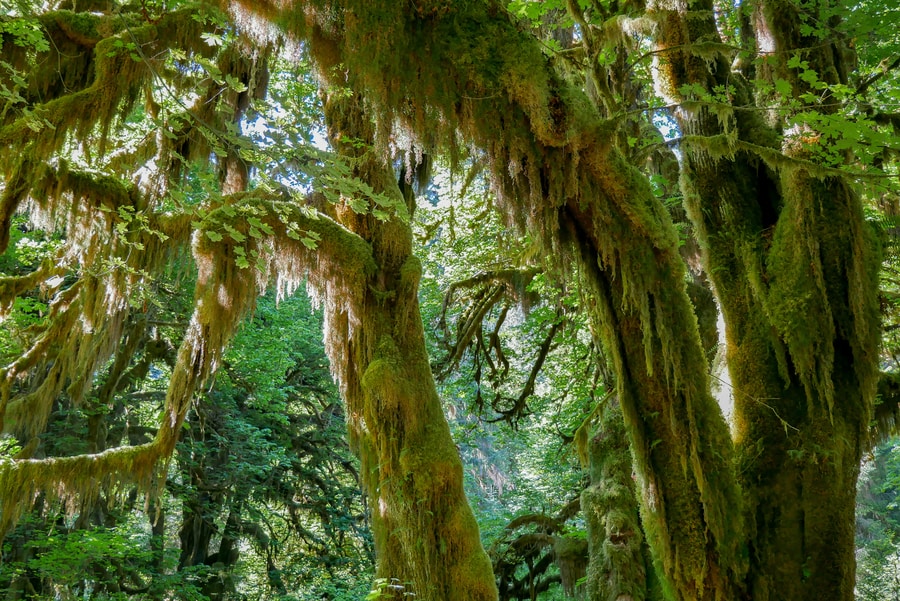
Visiting all the top landmarks and attractions in Olympic National Park can be time-consuming. The park’s disjointed sections and indirect roads make it a difficult place to discover as a day trip or weekend getaway.
But if you slow down and take your time to enjoy its myriad attractions, Olympic National Park will reward you with some of the largest tracts of wilderness in the continental US.
-
NORTH CASCADES NATIONAL PARK
North Cascades National Park is an untamed wonderland that lies about two and a half hours northeast of Seattle. It is a hiker’s paradise that contains jewel-like lakes, evergreen forests, and spectacular panoramas.
The most beautiful sites in North Cascades National Park require getting off the beaten path and away from the main road.
Still, driving through the park makes for an excellent road trip. From the highway, you can enjoy the blue-green waters of Diablo Lake, and admire the towering peaks of the park’s eastern section.
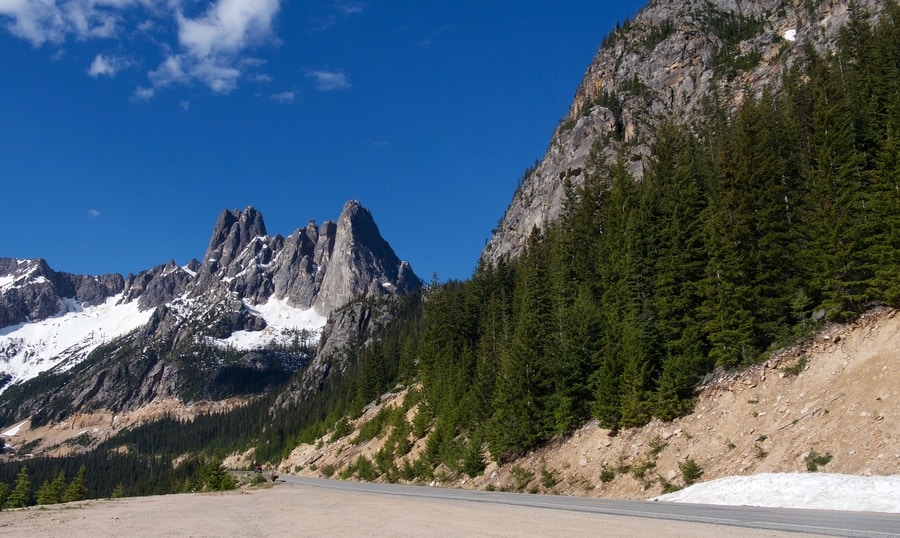
Like Olympic National Park, North Cascades is a place that takes time to explore in its entirety. Though I’ve traveled along the park’s main artery and stopped by its most famous viewpoints, I still feel unqualified to speak for the area as a whole.
It would take a lifetime to explore the miles upon miles of backcountry trails that crisscross the park’s jagged topography.
NATIONAL MONUMENTS IN WASHINGTON STATE
In addition to its national parks, Washington State contains three national monuments that reflect the state’s geological diversity. The United States defines a national monument as ‘a place of historic, scenic, or scientific interest set aside for preservation by presidential proclamation.‘
In other words, national monuments are not only places of great beauty, but they can also be places of significant historical value (whether it be geological or cultural).
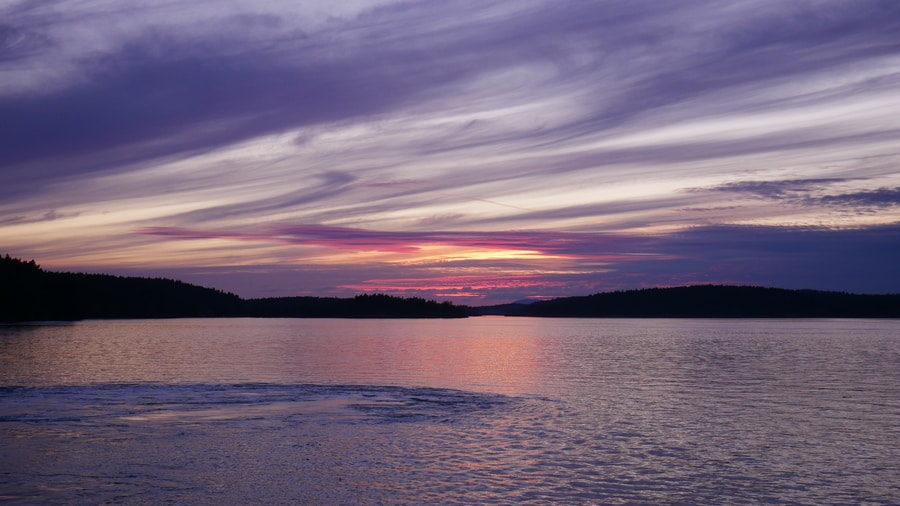
In Washington State, there are currently three places that are considered to be US National Monuments. They are Mount St Helens, the San Juan Islands, and Hanford Reach.
-
MOUNT ST HELENS NATIONAL MONUMENT
Mount St Helens National Monument is one of Washington State’s most iconic and well-known landmarks. It is among the most recognizable volcanoes in the Cascades, and a reminder that—while we imagine transformations in landscape to take place over billions of years—the topography of the Pacific Northwest is still active and evolving.
Four decades ago, Mount St Helens unleashed an eruption that expelled 520 million tons of ash into the skies above Washington State.
The eruption forever altered the appearance of the volcano and its surrounding landscape.

For the best views of Mount St Helens, I recommend stopping by the Johnston Ridge Observatory and following the spectacular path along Harry’s Ridge Trail.
If you are interested in visiting the largest lava tube in the contiguous United States, head to Ape Cave at the southern end of the park.
From what I am told, the 2.5 mile lava tunnel is similar to that found in Oregon’s Newberry Crater National Monument.
-
SAN JUAN ISLANDS NATIONAL MONUMENT
Situated in the northern reaches of Washington State’s Puget Sound, the San Juan Islands National Monument consists of nearly 450 islands and rock outcrops that lie scattered about the Salish Sea. The national monument—administered by the Bureau of Land Management—is home to a surprisingly diverse array of fauna. Its waters are a haven for harbor seals, porpoises, and orca whales.
While its tiny specks of land number in the hundreds, the San Juan Islands have four main inhabited islands—beloved Orcas, tiny Shaw, bustling San Juan, and bike-friendly Lopez.
With the exception of off-the-beaten-path Shaw Island, the San Juans have become some of Washington State’s most popular tourist destinations.
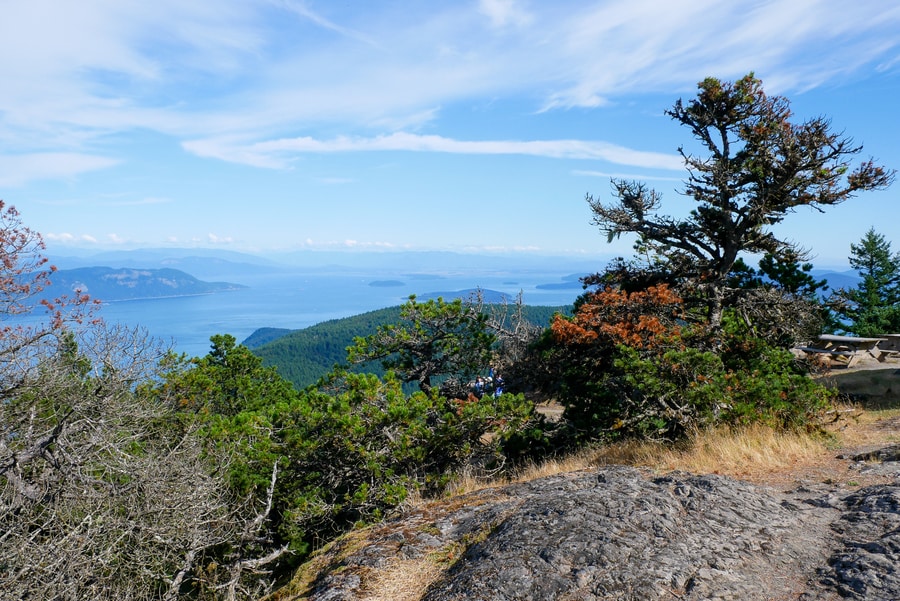
Though the San Juan Islands don’t have the magnificent splendor of some of the Pacific Northwest’s other attractions, they are idyllic and beautiful in their own way. They are an outdoor-lovers playground, an art-lover’s paradise, and serene retreats from the hubbub of urban life.
Visitors come to the islands for recreation, relaxation and rejuvenation.
-
HANFORD REACH NATIONAL MONUMENT
Though not as dramatic as the other parks and monuments in Washington State, Hanford Reach National Monument is a site of great national significance. The reach lies near the Tri-Cities in eastern Washington. It encompasses the last free-flowing stretch of the Columbia River.
The US government established Hanford Reach National Monument in 2000, mostly to protect the former security buffer around Hanford Nuclear Reservation.
At Hanford Reach, plutonium reactors stand as enduring relics of WWII. The nuclear reactors played a major role in 20th century history— fueling the ‘Fat Man’ bomb that rained over Nagasaki in 1945.
Today, the nuclear site stands idle over the surrounding landscape. The reactors have been dismantled, the surrounding waters have been cleaned, and nature has once more returned to the area.
I’ve visited the Tri Cities area twice: the first time to drive the Palouse Scenic Byway, and the second time to discover the Wallowa Mountains and Hells Canyon Recreation Area across the border in Oregon.
Despite my visits to southeastern Washington, however, I have yet to explore the Hanford Reach National Monument’s rehabilitated wilderness area.
WASHINGTON STATE NATIONAL FORESTS
If mountains aren’t the first thing that comes to mind when you hear mention of Washington, then you’re probably inclined to envision forest.
Western Washington’s forests carpet the landscape in a tapestry of emerald shades. Even central and eastern Washington have their share of verdant wonderlands.
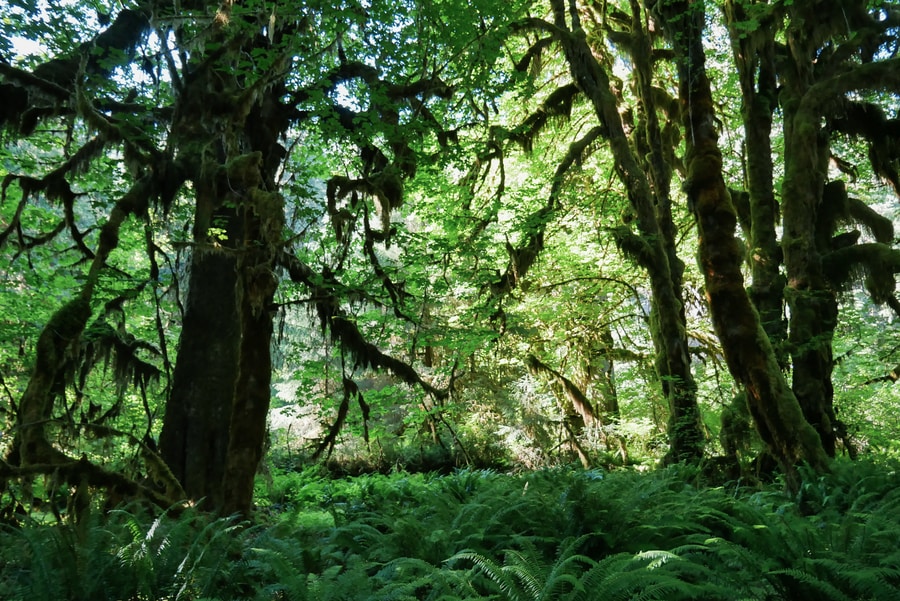
The five national forests in Washington State conceal alpine lakes, abundant fauna, and thousands of miles of hiking trails.
-
MOUNT BAKER-SNOQUALMIE NATIONAL FOREST
The Mount Baker and Snoqualmie forests were initially considered two separate areas that covered approximately four million acres and 900,000 acres respectively. In the 1970s, however, the US Forest Service administration combined the two adjoining swaths of land.
Today, the Mount Baker-Snoqualmie Forest covers a huge area of western Washington that stretches from Mount Rainier to the Canadian border.
It is home to glacier-covered peaks, spectacular mountain meadows, and old-growth forests.
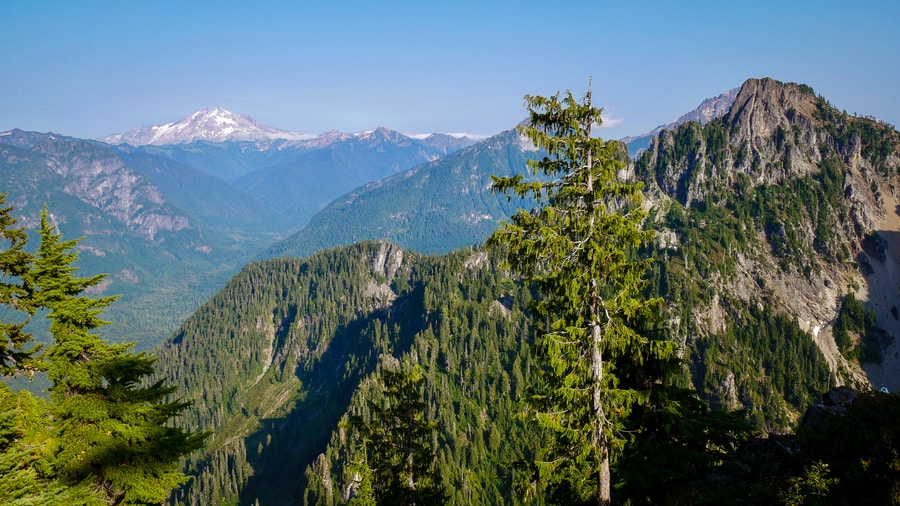
Due to its proximity to Seattle, the Mount Baker-Snoqualmie National Forest is one of the most popular forested area in the entire United States.
-
OKONOGAN-WENATCHEE NATIONAL FOREST
Like the Mount Baker-Snoqualmie Forest, the jointly-administered Okonogan-Wenatchee National Forest is a large and diverse landscape that encompasses over 4 million acres. It lies on the eastern slopes of the Cascade Range in Washington State and shelters some of the area’s most spectacular scenery.
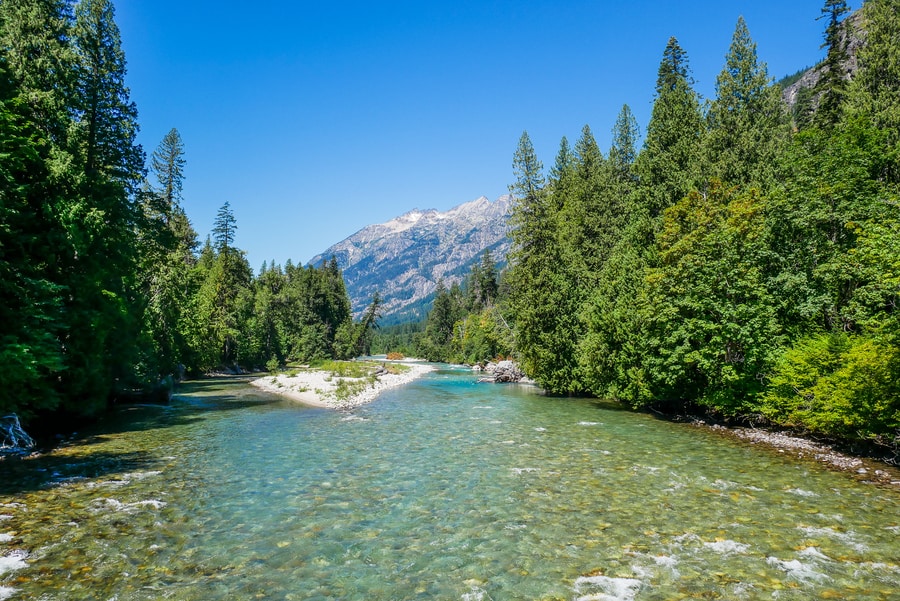
The Okonogan-Wenatchee Forest includes many of the areas around Highways 2, 20 and 90. As it extends eastward toward Leavenworth and Central Washington, its vegetation adapt to higher and drier climates. East of the Cascades Mountains, sweet-smelling Ponderosa pines replace the moss-laden Douglas firs characteristic of western Washington.
-
OLYMPIC NATIONAL FOREST
The Olympic National Forest includes patches of land adjacent to Olympic National Park. It boasts emerald mountainsides, rugged river valleys, and groves of moss-laden trees.
The ecologically diverse area is best known for its temperate rainforests that receive upwards of 220 inches of precipitation a year.
-
GIFFORD PINCHOT NATIONAL FOREST
Located in southwest Washington, the Gifford Pinchot National Forest covers more than one million acres of forests, mountains, waterfalls, valleys, and volcanoes.
It extends from the southern end of Mount Rainier National Park to the scenic banks of the Columbia River.
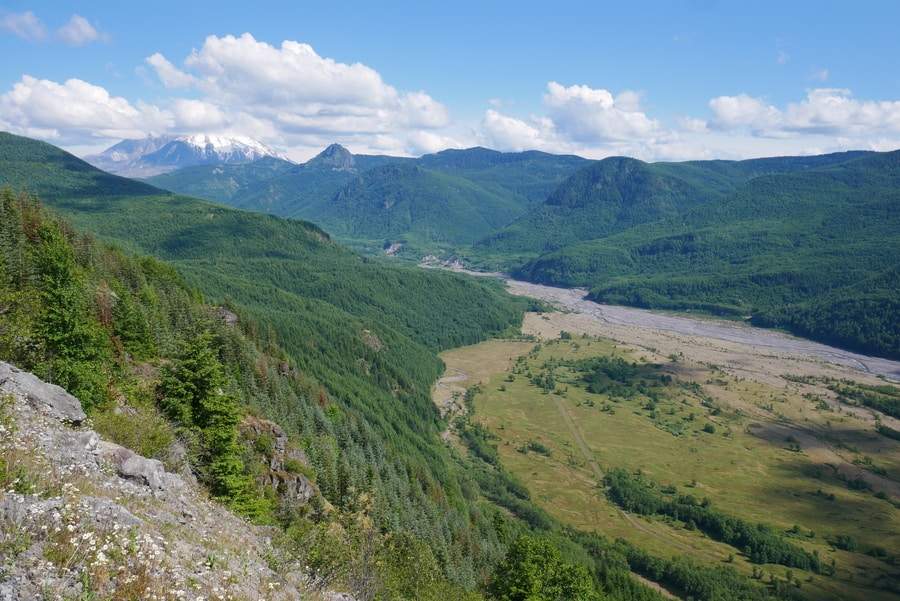
The forest has three main geographic districts: the Mount Adams Wilderness, the Cowlitz Valley near Mount Rainier, and the area surrounding Mount St. Helens.
Within its confines, it conceals many of Washington State’s most beloved scenic gems.
-
COLVILLE NATIONAL FOREST
The Colville National Forest is the most far-flung and remote of Washington’s five protected forests. It lies in the northeast corner of the state and is a popular getaway destination for residents of Spokane and northern Idaho.
The 1.1 million acre forest was formed over 10,000 years ago, when Ice Age glaciers carved eastern Washington’s valleys.
The forested hills in the northeast corner of Washington are noticeably less dramatic than the mountains that lie to the west. They are considered foothills of the jaw-dropping Rocky Mountains that house Glacier, Banff, and Jasper National Parks.
NATIONAL RECREATION AREAS IN WASHINGTON STATE
If there’s one thing that Washington residents and visitors love (besides coffee and beer) it is recreation. And with its lakes, rivers, mountains and sound, the state has more than enough areas to satisfy nature-loving adventure-seekers.
Washington has three federally protected national recreation areas. All of them center around elongated reservoirs that attract water sports enthusiasts during hot summer months.
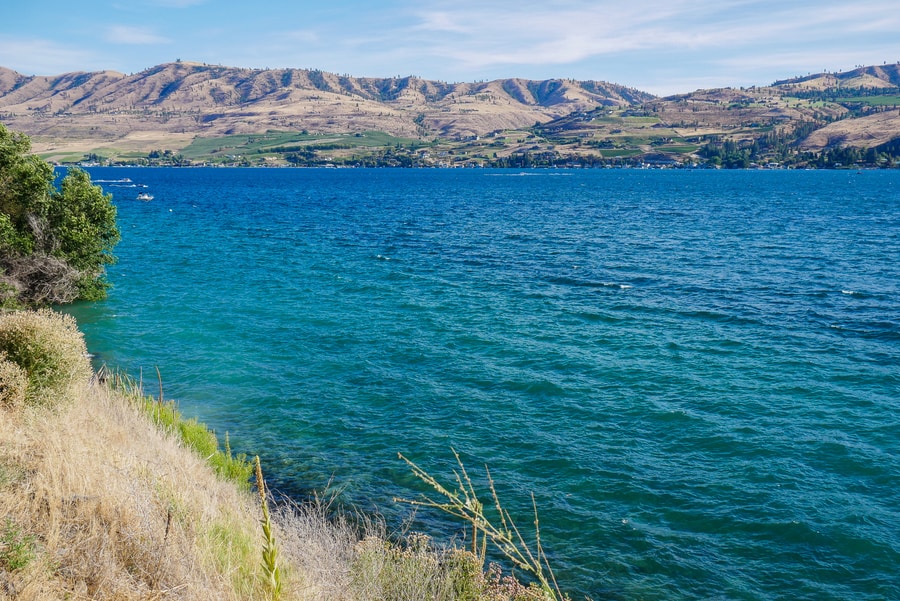
Lake Chelan, Roosevelt Lake and Ross Lake are the three national recreation areas in Washington State.
-
ROSS LAKE NATIONAL RECREATION AREA
Ross Lake National Recreation Area is the most accessible part of the North Cascades National Park Service Complex—a protected stretch of land that includes both the Ross Lake and Lake Chelan recreation areas. The Ross Lake Recreation Area contains three reservoirs: Ross Lake, Diablo Lake, and Gorge Lake.
Though it is most famous for its views of Diablo Lake, the national recreation area is a haven for fishing, canoeing, kayaking, and hiking.
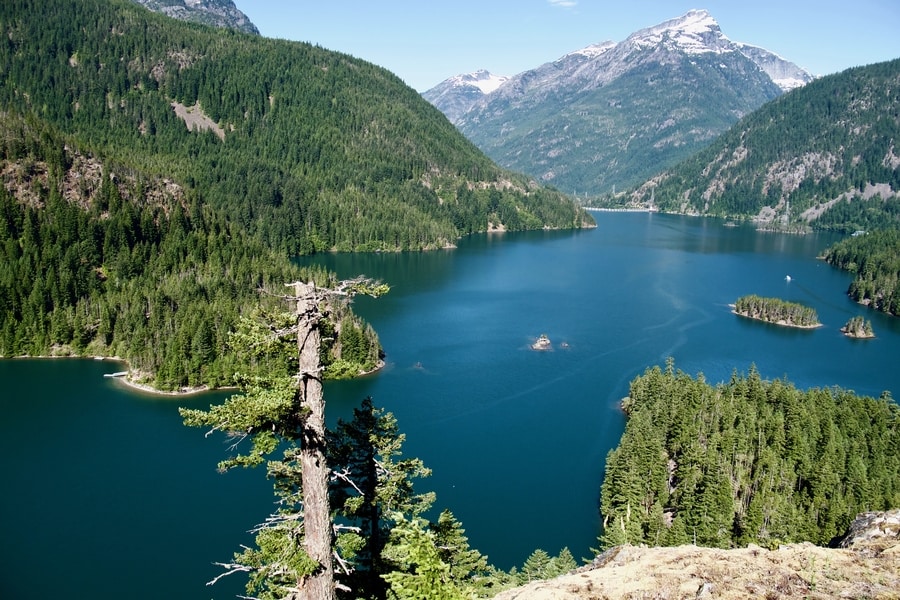
Ringed by mountains and characterized by its blue-green waters, it offers some of the most spectacular views of Washington’s North Cascades.
-
LAKE CHELAN NATIONAL RECREATION AREA
Lake Chelan is an elongated body of water that snakes through the hills of Central Washington. The popular recreation area is one of the state’s premier outdoor playgrounds and a top destination for Washingtonians with summer homes. With its sunny skies and impossibly blue waters, the lake is a magnet for anyone with a penchant for water sports and relaxation.
At its southern tip, Lake Chelan boasts sunny weather and vineyard-clad hillsides..
At its northern end, evergreen trees and towering mountains are the backdrop to one of Washington’s most remote corners.
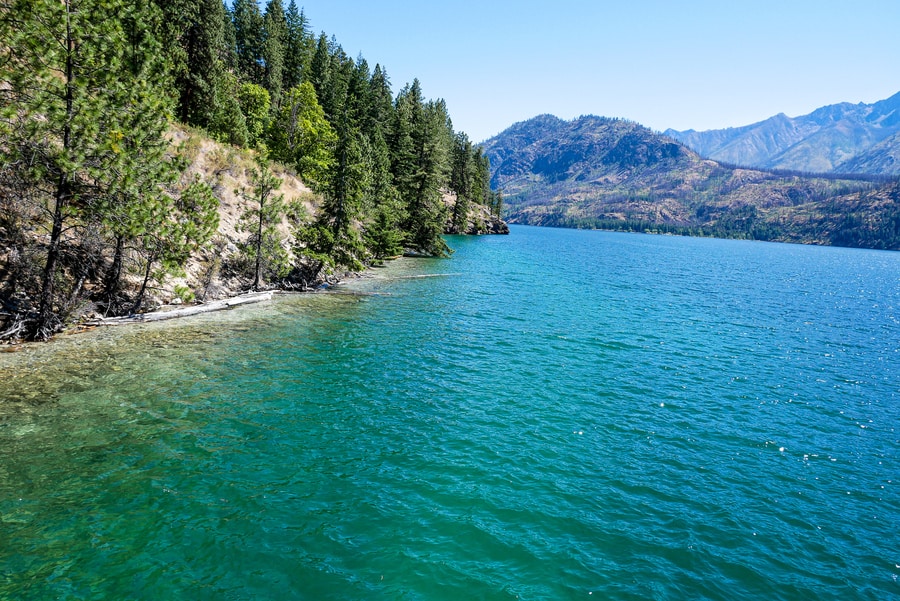
Due to the varied topography that flanks its shores, 55 mile-long Lake Chelan has a little bit of something for everyone.
-
LAKE ROOSEVELT NATIONAL RECREATION AREA
The Lake Roosevelt National Recreation Area is a top getaway destinations in eastern Washington. Positioned around a hill-flanked reservoir, the area attracts adventure-enthusiasts and outdoor-lovers from Spokane and beyond.
In addition to its artificial lake, highlights of the national recreation area include Fort Spokane and St. Paul’s Mission.
Lake Roosevelt is the state’s only federally protected recreation area that I have yet to visit.
PLANNING A TRIP TO WASHINGTON’S NATIONAL PARKS
The collection of parks, monuments, forests and recreation areas in Washington are a large part of what makes the state such an alluring destination for outdoor-lovers. They are integral to the state’s tourism industry and top reasons that Pacific Northwesterners love where they live.
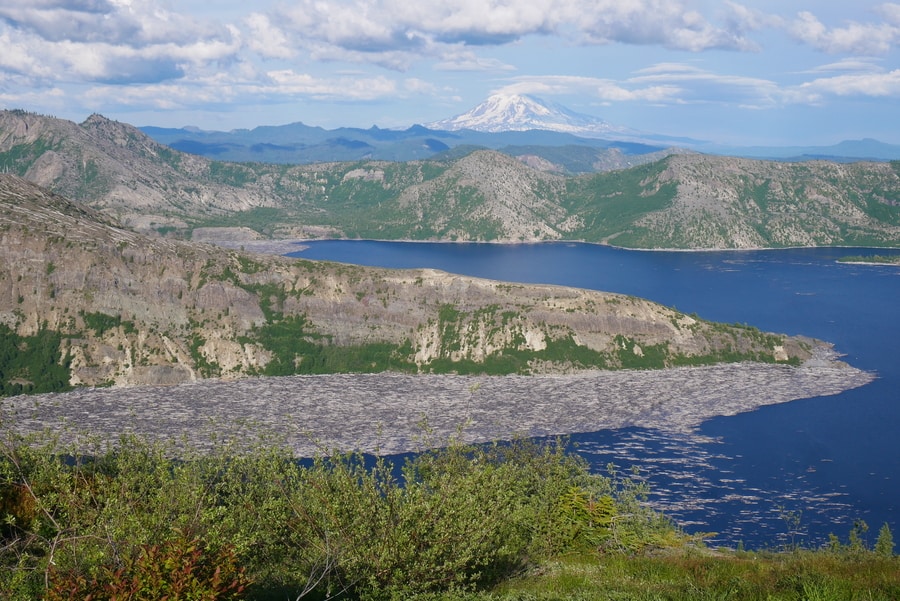
Yet, while this blog post may make you want to drop what you are doing and head straight to the national parks, it is worth noting that the federal lands in Washington aren’t always conducive to spur-of-the-moment trips.
In order to make the most of your trip to Washington’s public lands, it is a good idea to plan ahead. Checking the weather forecast, booking in advance, and consulting the National Parks Service website are integral in ensuring an unforgettable trip to Washington’s wilderness areas.
LODGING IN WASHINGTON NATIONAL PARKS
Since the national parks are among the top things to see in Washington State, they can often get crowded in peak months. Throughout summer, throngs of tourists descend on Washington’s federal lands to take advantage of camping, hiking, and recreational activities. As a result, last minute lodging availability can be scarce—especially if you are interested in camping.
Unless you’re planning on camping in the backcountry, it is a good idea to reserve accommodations ahead of time.
WASHINGTON NATIONAL PARK FEES
National park entrance fees vary by location. For both Mount Rainier and Olympic National Park, access costs $30 for a single visit and $55 for a yearlong pass. North Cascades National Park is completely free to enter and transit due to its position along a major thoroughfare (though parking at trailheads will incur a $5 fee).
If you’re planning to visit more than two parks within a calendar year, investing in an Interagency Pass is probably a good idea. The $80 passes cover all areas within the NPS jurisdiction—including national parks, national monuments, national recreation areas, and national forests.
They are valid for an entire year.
ENJOY THE SITES, BUT LEAVE NO TRACE
The national parks and monuments in Washington State have been designated in order protect the landscape from logging, development, and resource extraction. They are public lands meant to be enjoyed.
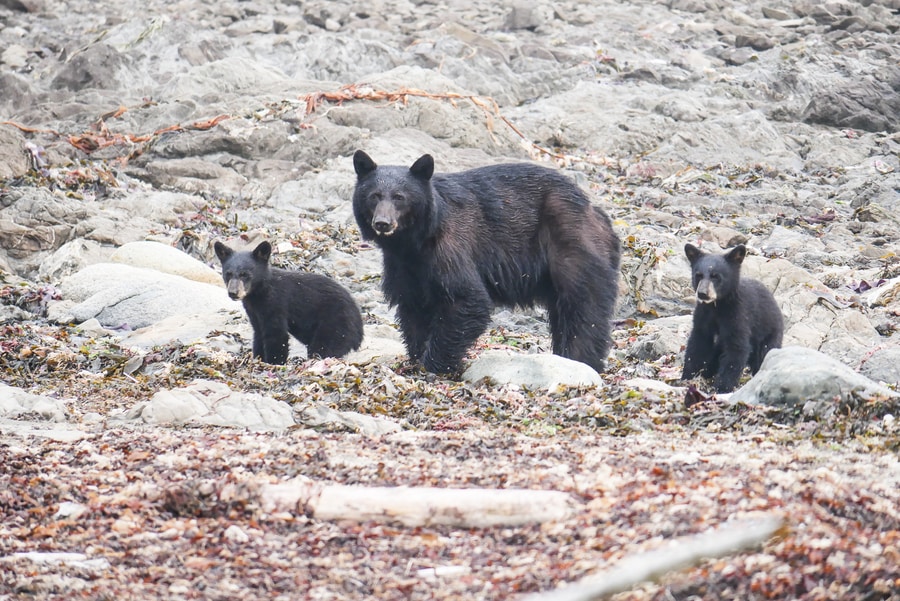
That being said, please leave no trace, respect wildlife, and adhere to burn bans during wildfire season.
Respecting the rules established by the NPS will ensure that the great outdoors remain unadulterated for generations to come.
****
Living in Seattle has given me access to some of the country’s top national parks and monuments. Within a few hours’ drive, I can find myself scrambling up a mountain, traipsing through the desert, or kayaking in the Puget Sound.
Though I often find myself complaining about Seattle traffic and the difficulties of getting away from the city’s endless sprawl, the truth is that I’m incredibly lucky to live in a place replete with such staggering natural beauty.
_____________________________________
Did You Enjoy this Guide to Washington State’s National Parks, Monuments and Forests? Pin It!
